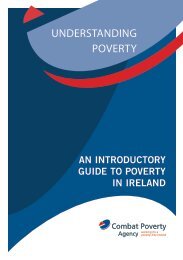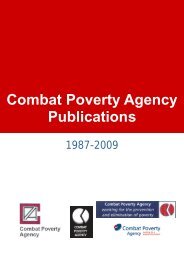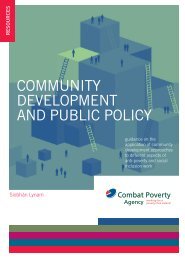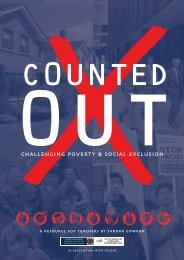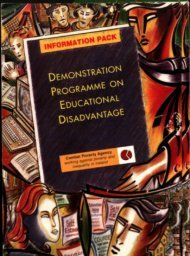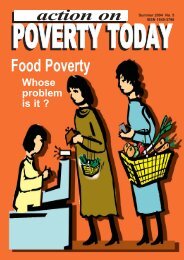Evaluating Integrated Responses to Educational Disadvantage (2000)
Evaluating Integrated Responses to Educational Disadvantage (2000)
Evaluating Integrated Responses to Educational Disadvantage (2000)
- No tags were found...
Create successful ePaper yourself
Turn your PDF publications into a flip-book with our unique Google optimized e-Paper software.
SECTION 1EXECUTIVE SUMMARYThe Demonstration Programme on <strong>Educational</strong> <strong>Disadvantage</strong> was set up initially for three years,1996 - 1999, by the Combat Poverty Agency. Under this programme, four local network groups,based in Drogheda (Co. Louth), Killinarden (Co. Dublin), Tralee (Co. Kerry) and Tuam (Co. Galway),were funded following a widely publicised competitive process. The aims of the networks were <strong>to</strong>develop integrated, co-ordinated responses <strong>to</strong> the problems of educational disadvantage within theirareas and <strong>to</strong> contribute <strong>to</strong> influencing policy in relation <strong>to</strong> these issues. Following an interim evaluationreport on the programme in 1998, it was decided <strong>to</strong> extend the programme <strong>to</strong> the end of <strong>2000</strong>.The main background <strong>to</strong> setting up the Demonstration Programme was growing concern with theissue of early school-leaving and mounting evidence of the relationship between educationalattainment and poverty. The Combat Poverty Agency started <strong>to</strong> develop a strategy for dealing witheducational disadvantage issues during the early 1990s. Subsequently, the Demonstration Programmebecame the main component of this strategy. Research, creating public awareness on educationaldisadvantage, and the development of a poverty awareness programme for school curricula were othercomponents of the programme.* At the time, a growing number of government initiatives focused on integrating local communityefforts <strong>to</strong> tackle pervasive social problems. These initiatives concerned long-term unemployment, localdrug problems, childcare matters and local and community development. The development of a localpartnership structure was an important organisational dimension <strong>to</strong> these initiatives. They brought<strong>to</strong>gether the main statu<strong>to</strong>ry and voluntary interests dealing with specific issues, alongside communitybodies and other persons directly affected by the issues. The Demonstration Programme adopted thismodel and was structured <strong>to</strong> support local network groups dealing with educational issues in the fourareas.* The Demonstration Programme emphasised the value of achieving more effective home-schoolcommunitylinkages and in particular of promoting and developing the roles of non-school communitybodies and parents in tackling children's educational needs. This approach was based on an analysisthat recognised that educational disadvantage grew out of a "discontinuity between the school andthe non-school experiences of disadvantaged children" 3 and that interventions needed <strong>to</strong> go beyond"conventional schooling".* Support for integrated approaches is evident across the literature spanning theory, policy and practice.The five papers written as part of the Demonstration Programme Policy Aspects of <strong>Educational</strong><strong>Disadvantage</strong>s, discussed the theoretical and practical arguments for adopting an integrated approach* The Combat Poverty Agency supported the Demonstration Programme in the context of its widerstrategy <strong>to</strong> promote community development as an anti-poverty measure. Its model of communitydevelopment is one of supporting self-organised groups <strong>to</strong> take direct responsibility <strong>to</strong> initiateappropriate actions in response <strong>to</strong> local problems. Empowerment and participation are importantconcepts in this work. The Demonstration Programme was envisaged as a community developmentmeasure. Although the programme brought <strong>to</strong>gether personnel and bodies from other sec<strong>to</strong>rs, it wasbasically oriented <strong>to</strong>wards promoting community development in tackling educational disadvantage.' Education and Poverty; Eliminating <strong>Disadvantage</strong> in the Primary School Years A Discussion Paper by: the Education Commission ofThe Conference of Major Religious Superiors<strong>Evaluating</strong> <strong>Integrated</strong> <strong>Responses</strong>( <strong>Evaluating</strong> <strong>Integrated</strong> <strong>Responses</strong>



